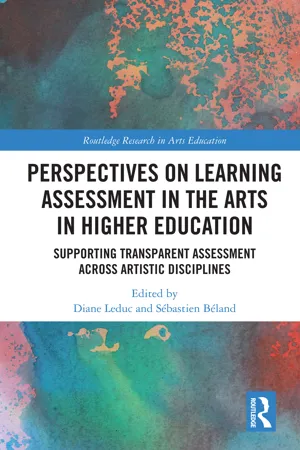
Perspectives on Learning Assessment in the Arts in Higher Education
Supporting Transparent Assessment across Artistic Disciplines
Diane Leduc, Sébastien Béland, Diane Leduc, Sébastien Béland
- 301 pages
- English
- ePUB (mobile friendly)
- Available on iOS & Android
Perspectives on Learning Assessment in the Arts in Higher Education
Supporting Transparent Assessment across Artistic Disciplines
Diane Leduc, Sébastien Béland, Diane Leduc, Sébastien Béland
About This Book
Drawing on theoretical and empirical insights from art teachers in Canada and Europe, this edited volume explores the question of how learning in the arts can be effectively and fairly assessed in the context of higher education.
The chapters consider a rich variety of assessment practices across music, visual and plastic arts, performing arts, design, fashion, dance and music and illustrate how knowledge, competencies, skills and progress can be viably and fairly assessed. Contextual challenges to assessment are also considered in depth, and particular attention is paid to the challenges of reconciling teaching in the arts, aimed at an intuitive transformation of the student, and assessing learning that takes on its meaning in subjectivity and sensitivity.
This text will benefit researchers, academics and educators in higher education with an interest in assessment in the artistic disciplines and in the topic of creativity more broadly. Those specifically interested in educational assessment policy and the visual arts will also benefit from this book.
Frequently asked questions
Information
Table of contents
- Cover
- Half Title
- Series
- Title
- Copyright
- Dedication
- Contents
- List of Figures
- List of Tables
- List of Text Boxes
- List of Abbreviations
- About the Contributors
- Foreword
- Acknowledgements
- Introduction
- Part One Fundamental Perspectives: About Subjectivity and Intentionality
- Part Two Broader Perspectives: From the Audition to the Graduation
- Part Three Overlapping Perspectives: Between the Fear and the Wow!
- Part Four Applied Perspectives: Of Competencies and Practices
- Index